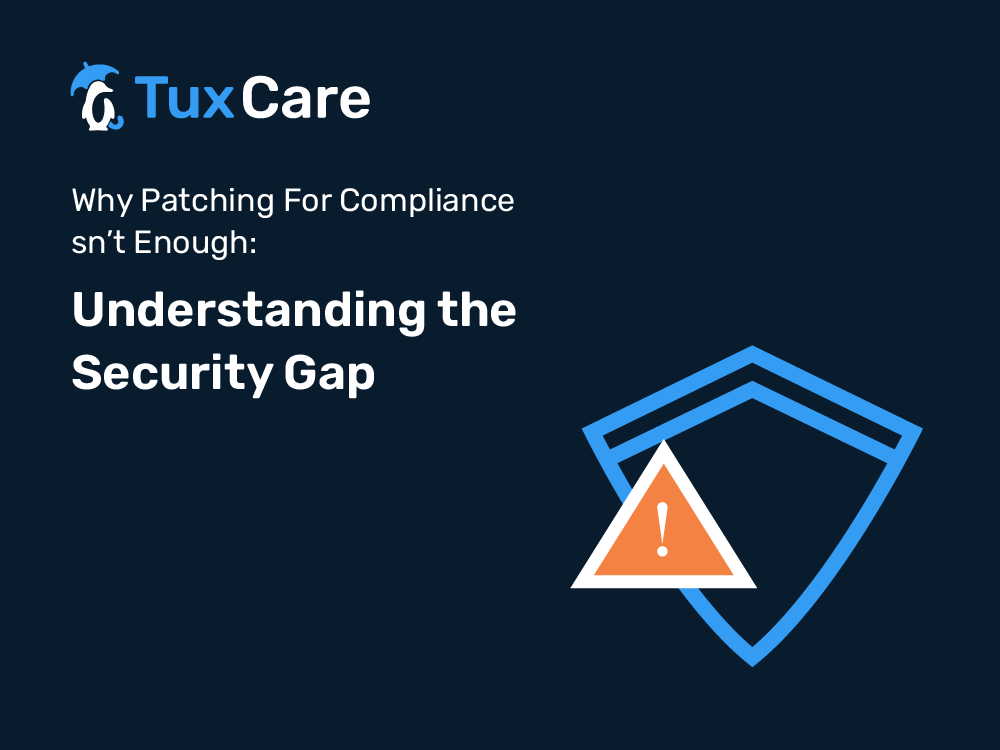Why Patching for Compliance Isn’t Enough: Understanding the Security Gap
Meeting compliance requirements means that individuals or organizations comply with the relevant laws and regulations. They are essential for maintaining accountability and protecting an organization’s sensitive data. Failing to comply can lead to legal fines and penalties according to the rules.
Patching is the process of updating software or systems to fix bugs or vulnerabilities. It protects the system against cyber threats and plays a crucial role in achieving compliance requirements. However, the goal should not be solely to meet the compliance metrics. Instead, organizations should approach a holistic patch management strategy that aligns with industry standards and ensures the complete protection of their systems and data.
This blog post will discuss the limitations of patching for compliance and why it falls short, as well as cover how to provide robust security against fast-moving threat actors and emerging cyber threats.
Related Article: Patching for Compliance: How Regular Patching Can Help Organizations Meet Regulatory Requirements
Patching and Compliance: How Do They Align?
Before we start, let’s understand patching and compliance, the two essential components of data security, and how they share interrelated objectives. Patching mainly focuses on technical fixes for vulnerabilities, such as updating systems and software. In contrast, compliance involves the requirements for data protection, access restrictions, incident response, or even patching.
If we look carefully, both patching and compliance involve the objective of addressing vulnerabilities. Patching ensures that security vulnerabilities are fixed, highly reducing the risk of exploitation by cybercriminals. On the other hand, organizations are often required to show that they proactively address security vulnerabilities through patching processes to achieve regulatory requirements. Meeting these criteria ensures that organizations follow industry standards and protect sensitive information.
Patching and compliance both show how seriously an organization manages the protection of its systems and data. While meeting compliance requirements demonstrates a dedication to upholding established regulatory requirements, patching shows proactive attempts to avoid cyber threats.
Patching vs. Compliance: How Do They Differ?
While patching and compliance share a common purpose, there exists a significant security gap between the two. Security vulnerabilities are constantly evolving and attackers are actively looking for new techniques to exploit the system. Therefore, security patches must be deployed quickly to avoid putting organizations at high risk.
The time period specified by compliance standards was often agreed upon at a time when the speed with which vulnerabilities are exploited was much longer than what happens today. A time period of 30 days provides a time window where organizations can patch close to the end of that time and still meet compliance. This compliance window, is, unfortunately, quite long. During this window, malicious actors can exploit the vulnerabilities, potentially causing significant damage. Thus, patching can help you meet compliance requirements, but it fails to address this time lag, exposing organizations to potential risks.
Another major issue with compliance-driven patching is zero-day vulnerabilities, which are unpatched security flaws that vendors are unaware of. Attackers can take advantage of such vulnerabilities before patches are available, making them particularly challenging to protect against through patching for compliance alone. To defend against such threats, organizations must adopt a holistic patching approach that considers zero-day attacks and their specific risk profiles.
Patching that is primarily focused on compliance often falls behind constantly evolving cyber threats. Organizations face difficulties in responding quickly to new attack vectors and emerging cyber threats, leaving them open to advanced attack techniques. In the event of an attack, organizations must respond promptly to remediate the issue and prevent additional harm. However, relying solely on compliance-oriented patching could delay the incident response time since it prioritizes compliance metrics over immediate security fixes.
Therefore, meeting regulatory requirements does not ensure complete protection against cyber dangers. By assuming that being compliant renders them completely secure, enterprises might develop a false sense of security when, in fact, they may still be vulnerable to potential risks.
Final Thoughts.
In regulatory compliance is essential for data security, an organization’s patching approach shouldn’t only be centered on it. Relying on patching just for compliance might expose enterprises to evolving cyber threats, fast-moving threat actors, and zero-day vulnerabilities. Thus, organizations need to take a proactive, all-encompassing strategy to patch that considers the dynamic threat environment and incorporates timely updates for known and undiscovered vulnerabilities to strengthen their security defenses effectively.
KernelCare Enterprise is an automated live patching solution that helps you stay compliant and minimize downtime for Linux servers by allowing you to patch without having to reboot. By applying security patches automatically in the background, while systems are running, organizations can deploy each patch as soon as they’re available – so no patch needs to get delayed for a scheduled maintenance window.
KernelCare Enterprise can live patch all popular Linux distributions, such as Ubuntu, Debian, RHEL, CentOS, AlmaLinux, Rocky Linux, Oracle Linux, and more. Check out all supported distributions and kernels here.



 Documentation
Documentation Login
Login




